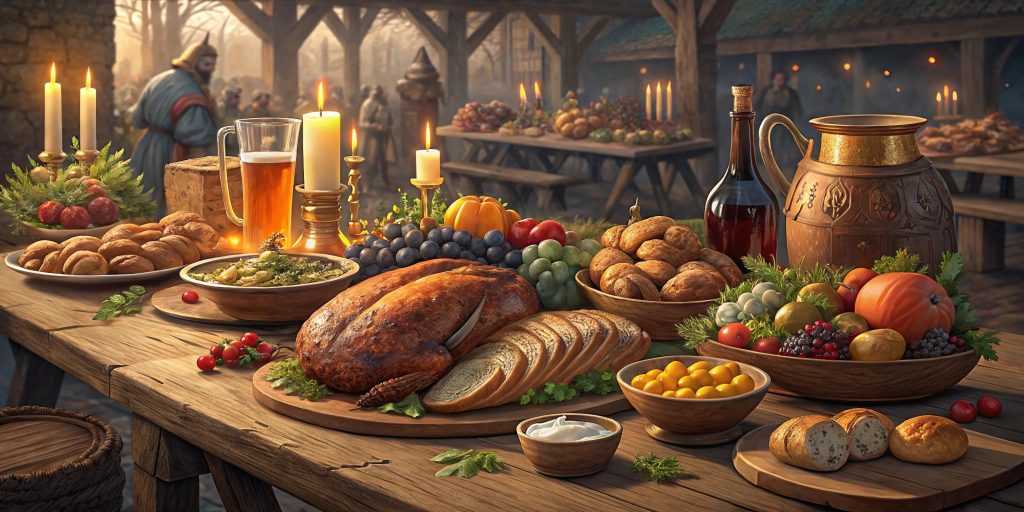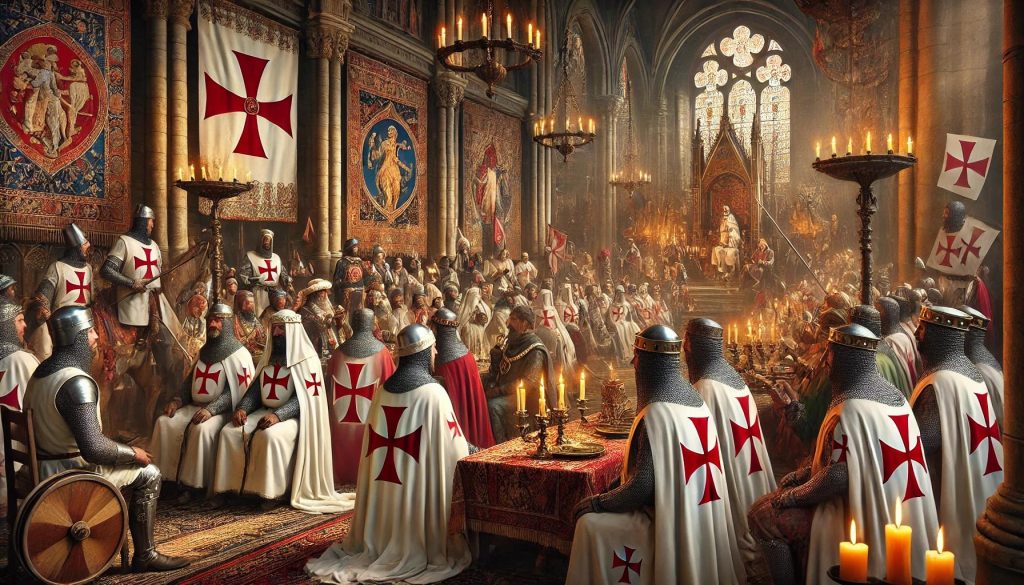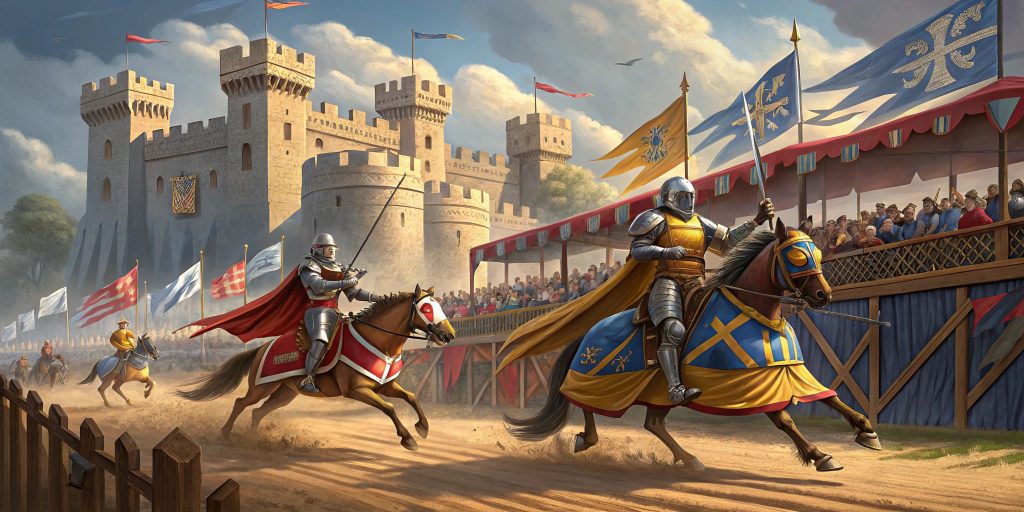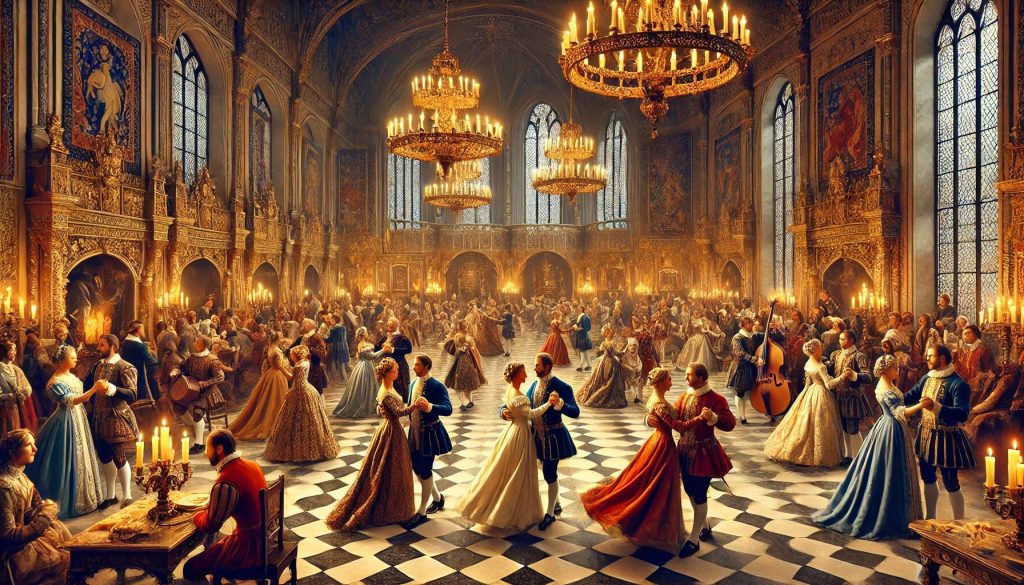The medieval period lasted from the 5th to the late 15th century. It was filled with cultural practices and social customs. Feasts and festivities were key, blending social gatherings with religious observances.
Templar gatherings were special. They mixed ritual with celebration, creating a unique cultural experience.
Leisure and entertainment in medieval times tell us a lot about society. Grand banquets and big festivals for every season united people and strengthened community bonds.
They were not just for fun. They helped keep the moral and social fabric of medieval life strong. Exploring these traditions shows their importance in history and culture.
Introduction to Medieval Entertainment
The medieval era was full of entertainment, showing the rich culture and social life of the time. People from different classes enjoyed entertainment in their ways. The rich had fancy events, while the poor had simpler, shared activities.
Local traditions and cultural practices shaped the entertainment of the era. Festivals, religious events, and daily life brought joy to many. The Church’s influence was significant, mixing with local celebrations and shaping leisure for everyone.
Monarchies and local leaders also changed how people saw and enjoyed entertainment, influencing popular entertainers. In this complex world, entertainment was a fun activity and a way to show society’s values, often displayed in grand castles.
Feasts and Banquets: The Center of Social Life
So, what did medieval people do for entertainment? Feasts and banquets were key in medieval society. They were entertainment that brought people together and showcased the nobility’s wealth and power. These events were more than just food; they helped form alliances and strengthen relationships.
Lavish Banquets and Their Importance
Lavish banquets were very important. They let nobles show off their status with fancy food, drinks, and shows. These gatherings were where big decisions were made, and friendships were strengthened.
The customs and rituals at these feasts showed the values and social order of the time.
Food and Drink at Medieval Feasts

Food and drink were at the heart of these events. Guests enjoyed many dishes, like those served at a medieval times dinner:
- Roasted meats, such as venison and pork
- Spiced wines, often infused with herbs and fruits
- Unique dishes made from local agricultural produce
These foods showed off the area’s crops and the host’s generosity. The way food was presented added to the event’s grandeur. By enjoying these foods, guests were part of a shared medieval culture.
Festivals and Fairs: Celebrating the Seasons
Medieval celebrations were full of life and many events. Big festivals were vital to community life, and local fairs and festivals helped people trade and bond.
These events were filled with activities that brought people together. They made life richer and helped people feel part of a community.
Major Festivals in the Middle Ages
Medieval festivals were big deals tied to farming and faith and were a popular form of entertainment for medieval people. Easter and Christmas were spiritual highlights with big feasts and decorations. Harvest and Midsummer were also big, filled with joy.
Activities During Medieval Fairs
Fairs and festivals offered lots to do. Music and dance were everywhere, and performers entertained everyone. Games like jousting and archery were big hits.
Market stalls had all sorts of goods for trade. These events were key to community life, showing how medieval people interacted and traded.
Templar Gatherings: Significance and Ceremonies
Templar gatherings were key in medieval society. They were for religious and social needs, showing the Templars’ strong beliefs in chivalry and Christianity.

These meetings helped the Templars feel like a family and ensured everyone knew they were part of something special.
The Role of Templars in Medieval Society
The Knights Templar were more than fighters. They played big roles in community life, and their meetings helped them in many ways.
They built solid networks and showed unity. They shared their values with everyone, often through stories told by entertainers. This made them important in society.
Religious Observances in Templar Gatherings
Religion was at the heart of Templar meetings. They had prayers, readings, and sacraments. These acts were not just rituals.
They helped the Templars stay true to their faith, and these ceremonies showed their deep devotion. They were important in the Christian world.
Types of Entertainment in Medieval Times
Medieval society loved many kinds of entertainment. Minstrels were key, bringing music, stories, and performances to gatherings. Their tales and songs made celebrations and feasts lively.
Games and sports were also big, especially for the nobles. They showed off their skills and had fun, which was a way to relax and show off.
From Minstrels to Mummers
Minstrels and mummers changed the Middle Ages’ entertainment. Minstrels traveled, sharing songs and stories. They often performed at feasts and fairs.
Mummers did theatrical shows with skits and plays. They made people laugh and connected them. Their stories were passed down through time, preserving the culture of medieval people.
Games and Sports Popular Among Nobility
The nobles enjoyed games and sports, too. Hunting was a favorite, showing off their tracking skills. Archery contests tested their aim and precision.
Board games like chess and backgammon were also popular. They were fun and helped people connect. These activities showed off social status and friendship.
Jousting and Tournaments: Knights at Play
Jousting became a big deal in medieval entertainment. It started as a way for knights to practice fighting. Soon, however, it turned into a show where knights showed off their skills to big crowds.
Tournaments became big events. They were not just for competition. They were also a time for people to unite and show pride in their communities.

The Rise of Jousting as a Popular Sport
Jousting grew into a sport loved by the nobility. Knights wore fancy armor with their family symbols. They competed for honor and fame.
The thrill of charging at each other on horseback was exciting. It made jousting a big part of medieval culture.
Competitive Events in Tournaments
Tournaments had more than just jousting. They also had:
- Melee battles, where knights fought each other in groups
- Archery contests for accuracy
- Foot competitions that tested agility and fighting skills
These events drew large crowds. People loved to see the knights’ bravery and skill. They brought the community together and celebrated the nobility’s abilities.
Middle Ages Entertainment: Pastimes for All Classes
Medieval society had many entertainment activities for everyone. The nobility enjoyed fancy parties and events, but the lower classes found fun in simpler things.
This shows how rich medieval culture was. It had something for everyone.
Leisure Activities for Nobility and Peasants
Nobles loved to hunt, dance, and throw big feasts. These were fun and helped them show off their status.
On the other hand, peasants enjoyed community events, games, and stories, which brought people together during festivals or market days.
Board Games and Dice among the People of the Middle Ages
Board games and dice were big in medieval fun. Games like backgammon and dice games were popular entertainment for everyone. They were fun and helped people practice skills.
These activities showed that fun could bring people together. They helped bridge the gap between different classes.
The Role of Animals in Medieval Entertainment
In medieval times, humans and animals were closely linked through entertainment. This bond showed off status and skill, especially in falconry and other animal acts. Animals in shows reflect what society values and the wonder of nature.
Falconry: A Noble Pursuit
Falconry was a top sport for the nobility, showing their wealth and talent. It involved training birds to hunt, showing off the bird’s skills and the falconer’s. Hunting with falcons was exciting and showed who was important, as it was a favored pastime among the nobility.
People loved to watch falconry events, where hawks showcased their hunting skills. They saw the birds fly beautifully and the special bond between humans and birds.
Other Trained Animals in the Arena
There were many other animals in the shows, too. Dogs did tricks and showed off their agility. Bears and horses also performed, adding to the fun.
These shows showed the connection between humans and animals and how animals contributed to the fun and joy of medieval times.
Religious Festivals and Observances
Religious festivals were significant in medieval times. They gave people a break from work and brought them together, helping strengthen community bonds and faith.
Significance of Feast Days in Medieval Life
Feast days were times for prayer and reflection. They united people to honor saints and key Christian events, helping them feel part of a community.
Celebrating Saint’s Days and Their Activities
People enjoyed processions, feasts, and performances on saint’s days, often featuring jugglers and troubadours. These activities made life more joyful and connected to faith. Music and games turned ordinary places into joyful spots.
Conclusion
In summary, medieval entertainment was full of social customs, leisure activities, and religious events. These activities brought people together and showcased their culture. They were a big part of daily life, offering a break and demonstrating what people believed in.
Looking into these traditions helps us better understand medieval life. It shows how these old ways still shape our views on fun and relaxation today, reflecting entertainment in the Middle Ages. Games, animals, and religious events were key to medieval life and still influence us today.
Thinking about medieval entertainment and society shows us how rich and complex it was. Exploring this era helps us see how it affects us today. It shows the lasting impact of medieval ways on our culture and how people interact over time.

